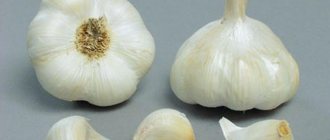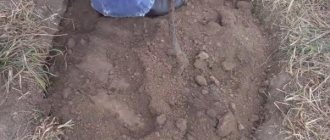Description of the Bogatyr variety
Bogatyr garlic is a winter variety. Shooting crop, annual. The root system is developed, fibrous, located at the base of the bottom of the head, branches on the sides, can grow up to 50 cm long. The false stem is white, formed by the upper leaves. The leaves grow 20-60 cm long and 1-2 cm wide. Each bush has about 5 leaves. The arrow on which the flower grows is located in the center.
Bogatyr garlic is grown primarily for its large, tasty heads.
The head grows round in shape, but slightly flattened on top. The average weight of the bulb is 85-120 g. Each head has 5-7 large cloves. The average weight of one clove is 10-12 g. The cloves are elastic, spaced evenly around the garlic clove. The scales covering the cloves are light at first, but as they dry, they begin to darken, turning purple or brown. And the head itself is covered with white scales. The taste is spicy, garlicky, the aroma is strong due to the abundance of essential oils in the composition.
Important!
Bogatyr garlic is grown primarily for its large, tasty heads. Green leaves do not carry the same important meaning; they can be eaten, but this variety is not suitable for forcing into greens.
Productivity
The creators of “Bogatyr” insist that this variety is high-yielding. But they do not provide information in numerical terms. In this case, the originator (creator/owner of the variety) indicates that:
- heads weigh on average 80 g, maximum weight - 115 g;
- one slice weighs on average 13 g.
The originator states that the yield of “Bogatyr” practically does not depend on the characteristics of the soil.
Based on the initial data, let’s try to calculate the productivity of “Bogatyr” ourselves:
- The variety has a powerful root system - its area is about 50 square meters. cm.
- When planting according to the 17x45 pattern, 6-7 cloves fit on a 1 m long bed.
- For 1 sq. m fits 2 rows - that's 14-16 cloves. Each clove will yield a head of garlic weighing 80 g.
To calculate the yield, multiply the weight of one head by the number of heads grown per 1 square meter. m: 80 g x 15 pcs = 1200 g. It turns out that for 1 sq. m harvest 1.2 kg of garlic.
Characteristics of garlic Bogatyr
Also check out these articles
- Chinese silk chicken - characteristics of the breed
- How to choose the right melon
- Raspberry jam
- How to make feed for rabbits
The positive and negative aspects of Bogatyr garlic are presented in its characteristics.
- Winter hardiness is high. Garlic tolerates autumn planting well, does not freeze in winter, germinates early in spring and does not deteriorate during return frosts.
- The size of the head and teeth is large.
Head and teeth size – large
- It is unpretentious in care and undemanding to the soil.
- Productivity is high and stable.
- The variety is immune to a variety of diseases.
- The harvested crop can be stored for up to six months.
Large garlic is easy to process and process. If the family loves large cloves of garlic, then the Bogatyr variety is an ideal option for planting.
Where is it recommended to plant?
The Bogatyr variety is universal - it is suitable for the southern and northern regions. This winter variety of garlic grows safely under any soil and climatic conditions.
Other winter varieties of garlic are discussed in this article.
To ensure maximum yield of the Bogatyr variety:
- choose areas with good lighting;
- the site should not be waterlogged or swampy, otherwise the cloves planted in the ground will rot before spring in the wet soil;
- It is advisable to plant garlic after carrots, cucumbers, potatoes, tomatoes or zucchini.
When to plant garlic
Bogatyr garlic can be propagated either by cloves or by aerial bulbs. When planting a clove, the harvest is obtained in the first year. If you plant an aerial bulb, then in the first year only a one-toothed bulb will grow, and from it, in the second year, it will be possible to harvest full-fledged garlic heads.
Winter garlic is planted in the fall. Usually this is the beginning of November or a little earlier (in the northern regions). There should be approximately 35-40 days left until the first frost. It is not worth planting this garlic later, since the roots need time to take root in the ground.
Important!
To get a large harvest of garlic, you should choose only the largest and healthiest cloves or aerial bulbs for planting.
It is better to select a place for growing garlic in a lighted area. The soil should be soft, fertilized, not swampy. If garlic is planted in a waterlogged area, the bulb will rot in the ground. Even if it can develop fully, it will still not be stored for long, so the site is chosen to be flat or on a hill.
It is necessary to plant Bogatyr garlic in funnels or rows to a depth of 10-13 cm, with a distance of 15 cm between cloves
Important!
Garlic is not planted next to onions; the best predecessors are zucchini, tomatoes, carrots, and cucumbers.
Planting and productivity level
In order to obtain a good harvest, planting teeth should be selected in the largest sizes. If you take small ones, the harvest will become smaller every year.
For storage, you should choose a dry place so that the garlic does not become damp or rot. The choice of landing site is important. The best would be the land on which zucchini, carrots, potatoes and cucumbers were previously planted.
Landing dates
Garlic of the Bogatyr variety is winter; the description states that planting should be done in late autumn, 30–40 days before the first frost. If planting is done late, the garlic rots in the ground before it has time to take root.
If you plant the planting material too early, the teeth will sprout and subsequently freeze in the winter cold.
When planted in a timely manner, the cloves sprout and take root. It is also possible to plant in the spring, in which case the bulb will have one tooth. A large onion is taken for the next planting, which will subsequently produce an onion with 5–7 cloves. This method is used to improve the fertility and size of the bulbs of subsequent harvests.
See also
Correct timing when it is better to remove winter garlic from the garden for storageRead
Landing Features
For a good harvest, follow the following recommendations for planting Bogatyr:
- the clove is immersed in the ground 10–12 cm from the bottom;
- the gap between the teeth is 16-18 cm;
- it is important to fertilize the soil with manure before planting;
- rows are made with a distance of 45 cm;
- With the onset of the first frost, mulching is done.
In the spring and before harvesting, regular watering, fertilizing and loosening the soil is important. Removing weeds - as needed.
How to plant the Bogatyr variety
We recommend reading our other articles
- Geranium flower
- Vietnamese pot belly pig
- When to dig up tulips
- Onion variety Slizun
A week before planting garlic, you need to check the acidity of the soil and adjust it if necessary (pH should be neutral). Then fertilizers (superphosphate, compost or humus) are spread over the area and the earth is dug up.
Important!
If there are a lot of pests and diseases on the site, then you can water the soil with boiling water or a solution of potassium permanganate before planting crops. This technique will not completely prevent the development of insects or fungal spores, but will reduce their numbers.
It is necessary to plant Bogatyr garlic in funnels or rows to a depth of 10-13 cm, with a distance of 15 cm between cloves. The rows are made at a distance of 10 cm on average from each other. After planting, the cloves are covered with earth and covered with dry straw or leaves.
Features of caring for Bogatyr
Although Bogatyr garlic is an unpretentious plant, it still requires minimal care for optimal development.
- Watering begins only after the first shoots appear. Water should be added in small quantities.
During watering, the soil should not be swampy; between waterings it should dry out
The soil should not be swampy; it should dry out between waterings.
- The soil on the site is kept loose and soft all the time. Weeds are regularly removed, and the soil itself is loosened with a rake or hoe.
- To prevent the arrows from drawing strength from the crop, it is necessary to cut them off when they grow 8-10 cm above ground level. Cut arrows are used in conservation.
- Fertilizers are applied to increase yields, but even without them, if the land is fertile, you can get a decent harvest.
- After the bulbs are formed, it is necessary to treat the ground with wood ash, it will extend the shelf life of the garlic after harvesting.
Important!
Most often, diseases on garlic develop due to affected planting material. To avoid this, before planting, it is necessary to warm the cloves or airy bulbs in the sun (2 days), leave them in a salt solution (5 g/2 l of water) for 3 minutes, and then the same amount in a solution of copper sulfate (10 ml/2 l of water). ).
Disease resistance
Like all winter varieties, “Bogatyr” grows rapidly in the spring. It manages to ripen before microbes and pests take over. Thanks to this feature, “Bogatyr” manages to avoid most of the garlic misfortunes. The variety is resistant to nematodes - small worms that suck the juice from the plant.
Standard disease and pest prevention measures:
- compliance with crop rotation;
- timely removal of plant residues;
- digging the soil before planting;
- disinfection of planting material.
When to dig up winter garlic
Professional gardeners know that garlic will be stored well only if harvested in a timely manner. Cleaning is carried out in a short time. The crop reaches technical maturity in 100-110 days from the moment of germination. To understand that garlic is ready for harvesting, you can also rely on external signs. So, what indicates ripe garlic:
You can only dig up garlic when the soil is dry.
- The leaves dried up and began to droop to the ground. Since this variety has an arrow, the leaves may not fall to the ground, but they will still turn yellow and dry out.
- The inflorescences begin to crack. Of course, this indicator is checked only if the inflorescence is not cut off.
- The head of garlic is dense. To check this, you need to dig up one onion. In this case, the cloves will separate well.
Harvesting is carried out on a fine day, when the sun is shining or cloudy, but rain is not expected. The ground must be dry! The garlic is dug up with a shovel or pitchfork and taken out of the ground. The work is carried out carefully so that the heads are not touched, and it is also advisable not to damage the roots. The adhering soil from the heads is removed manually.
Important!
Garlic put aside for storage should be sorted at least once a month to identify spoiled heads in time.
Garlic storage
After harvesting, the garlic is laid out on the beds and dried for 5 days. If rain is expected, it is removed under a canopy. After drying, you need to remove the garlic indoors and continue drying for another 2 weeks. Only after this can the roots be cut off, leaving no more than 3 mm at the bottom of the head. The arrows and pagons are cut so that stumps up to 6 cm remain.
Winter garlic Bogatyr is stored at +2…+4 degrees in a dry, ventilated area
To store garlic, you can use cardboard boxes, wooden boxes, nets, and baskets. Winter garlic Bogatyr is stored at +2…+4 degrees in a dry, ventilated area. If storage conditions are met, it can last for about 6 months.
Both Bogatyr garlic cloves and its leaves are used in food. You can eat Bogatyr garlic fresh, or use it for processing (frying, boiling, pickling, drying and even freezing).
Interesting!
Those heads of garlic that began to deteriorate or sprout during storage should be planted in shallow boxes according to a 3x3 cm pattern. They will produce juicy greens that can be used for salads, first and second courses.
Reviews from gardeners about the garlic variety Bogatyr
The Bogatyr variety is known to many gardeners. The opinions of some summer residents about this garlic are presented below.
- Maxim Stolyarenko : “I chose garlic for planting based on intuition. The Bogatyr variety immediately attracted attention with its name, so I bought it. The garlic develops well, the heads are not deformed, and the harvest is good. While other varieties often had small or crumpled heads and poorly developed cloves, Bogatyr, with a lack of fertilizing and average soil quality, showed excellent results. Now I will plant every year.”
- Valentin Sklipis : “Before, no matter how much garlic I planted, small ones grew. Last year I finally decided to buy good planting material. The variety was chosen by Bogatyr. I liked the size of the teeth and its unpretentiousness. The garlic has grown wonderfully! The heads are large, the cloves are also not small. It's easy to clean and lasts a long time. In general, an excellent variety, I even gave several heads to friends and relatives for planting!”
- Alena Lobachova : “I always choose only large garlic for cooking and canning, but it’s not always available on the market, so I grow it myself. Bogatyr is the ideal variety for me. The heads are large, the cloves are also pleasing in size. It is easy to clean and stores well. Unlike other varieties, Bogatyr does not require a lot of fertilizer or attention, but I noticed that it grows best in loose soil. If the soil is heavy, the heads may grow crooked or develop poorly.”











